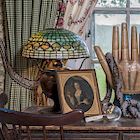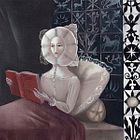Americana & International
On January 18th, 19th, and 20th, 2023, Pook and Pook will auction over one thousand lots of antiques and art. Anchored by several major collections, the sale will feature items from many estates, museums, and individuals. Wednesday January 18th is devoted to the Collection of Margaret Berwind Schiffer, the largest private collection of Chester County, Pennsylvania furniture known. Thursday the 19th will feature part two of one of the most prestigious private collections of American pewter in history, The Collection of Drs. Donald and Patricia Herr, as well as the Collection of the Packwood House Museum of Lewisburg, Pennsylvania. Friday the 20th will begin with one of the finest groups of brass candlesticks ever assembled: The Lear Collection of Copper-Alloy Socket Candlesticks, and conclude with fine art, silver, and rugs.

Over the course of decades, Margaret Berwind Schiffer assembled the largest known private collection of furniture originating from Chester County, Pennsylvania. A collector, scholar, and author, she illustrated many of her pieces in her classic books, representing some of the best examples of Chester County furniture and folk art. Rarities are found throughout the collection, such as an important Harrisburg silk on gauze needlework sampler dated 1807, wrought by Elizabeth Finney at Mrs. Leah Meguier’s School, and a Collection of Charles II stumpwork, which includes a silk embroidered casket, retaining its original case. Nearly all examples of early Chester County furniture styles are represented: a Chippendale walnut tall case clock, ca. 1775, has works signed by B. Chandlee, Nottingham, with an inlaid case adorned with pinwheel and tulips. A Chester County Queen Anne walnut tall chest, ca. 1760, is decorated with arched herringbone inlaid drawers and raised side panels. Another highlight is a Chester or Lancaster County Chippendale “Parrot” inlaid blanket chest, ca. 1760, featured alongside a miniature version, ca. 1810. One of several fine spice chests, a rare William and Mary cedar chest, ca. 1725, is decorated on all sides with compass inlays of potted tulips, and is most likely an early example from Philadelphia. A George I inlaid mahogany chest of drawers, probably Welsh, is dated 1696 and initialed IPS, the top and front profusely decorated. A Philadelphia William and Mary line and berry inlaid walnut chest of drawers, ca. 1730, stands alongside a Chester County Queen Anne line and berry inlaid chest of drawers, ca. 1750. A rare inlaid Queen Anne walnut cupboard, ca. 1750, is one of only two known examples of its kind. There are many singular tavern tables and Queen Anne dressing tables, and an exceptional series of Pennsylvania Queen Anne chairs that includes: a set of four, ca. 1760, purchased from a direct descendant of Lt. Col. John (Jack) Laurens, aide-de-camp to Gen. George Washington; a set of eight dining chairs, ca. 1745, consisting of a rare set of six and a near-identical pair; and an important walnut armchair, ca. 1750. A huge collection of weathervanes holds many sought-after examples, including a full-bodied copper gilt stag leaping over a log and shrubs, probably Harris & Co., and a full-bodied copper horse and rider by A.J. Harris & Son. Eighty lots of exceptional English and Dutch Delftware is headlined by four English plates of Chester County interest, all dated 1738 and initialed WG for William Gregg. These plates belong to a small group of known Delftware plates made for prominent Quaker families from Chester County. Other items include an English blue dash Queen Anne charger, ca. 1705, an English King George charger, ca. 1715, a rare rabbit hunting platter, and three labeled and dated English Delftware wine bottles: Claret 1648, Whit 1643, and Sack 1649.
Thursday begins with the Dr. Patricia and Donald Herr Pewter Collection, followed by The Packwood House Museum and other collectors and estates.
Herr Collection is headlined by a trove of rare Philadelphia finds: a pewter flagon, attributed to Johann Philip Alberti, is engraved Georg Kirchen, 1763. Also attributed to Alberti is a pear-shaped footed teapot, ca. 1770. Pieces by famed Philadelphia pewterer and patriot William Will include an elegantly proportioned teapot, ca. 1780, a quart mug, covered sugar, and a creamer, all bearing his touch mark. A rare teapot, late 18th c., is possibly the only example known bearing the Love touch mark. A flagon attributed to Love, ca. 1800, has St. Michael’s Lutheran church, Philadelphia provenance.
Other Pennsylvania pewter includes a Lancaster ciborium, ca. 1765, bearing the touch of Johann Heyne, and an exceedingly rare Peter Derr (Berks County 1793-1858) bronze spoon mold and pewter spoon, impressed P Derr 1820.
An important Albany, New York pewter communion service, ca. 1810, bearing the touch of Timothy Brigden, includes a pair of chalices, flagon, and a deep dish marked by Spencer Stafford, provenanced deaccessioned property from the Henry Ford Museum, which records the set purchased by Levi Morton Dewey, ca. 1840, from the church in Pomfret, New York, where he worshipped as a child. Other New York pewter includes quart mug, ca. 1780, bearing the touch of Frederick Bassett, a pewter chalice attributed to Henry Will, ca. 1775, and an Albany or New York pewter tankard, ca. 1785, bearing the touch of Peter Young. A tankard, ca. 1760 bears the touch of William Bradford, Jr.
Pennsylvania painted furniture on Thursday includes a rare pine hanging cupboard, dated 1843, the front decorated with a schoolyard scene with flagpole, children at play and bonneted teachers beneath a moon and starlit sky, all above a wooded scene with figures, dogs, and flying geese, provenance David Schorsch. A rare Samuel L. Plank (Mifflin County 1821-1900) painted pine and poplar hanging wall box retaining its original decoupage decoration with an old alligatored finish. Two orange-gold York County painted poplar dower chests, 19th c., retain their original vibrant decoration. Lancaster painted pine dower chests include one attributed to John Flory (Rapho Twp, 1754-1842) dated 1798, inscribed Sarah Richter, and another, signed by the maker Johannes Rank. Decorated with rampant unicorns and birds, a Berks County, late 18th c, example is another standout dower chest.
The only word to describe a Pennsylvania painted pine architectural shrank, ca. 1770, is monumental; the stepped cornice overhangs a central section with two elaborately decorated doors with painted birds and vases with flowers, above a two-drawer base, all resting on ball feet.
Another highlight is a Philadelphia Chippendale mahogany tea table, ca. 1770, the pie crust top tilting on a birdcage support, with suppressed ball standard and carved cabriole legs terminating in ball and claw feet. A Pennsylvania Chippendale tiger maple tall chest, ca. 1775, with highly figured graining, retains its original hardware.
A Dentzel, Philadelphia carved and painted carousel goat, ca. 1900, is attributed to the carver Daniel Mueller.
Artwork includes, an oil on canvas rendition of Gilbert Stuart’s 1806 Washington at Dorchester Heights, attributed to Jane Stuart (American 1812-1888). The youngest daughter of Stuart, Jane became well-known in her own right and executed numerous copies of her father’s works, most of George Washington. A copy of the same painting by Jane is in the collection of Mount Vernon. A mid 19th c. copy of Gilbert Stuart’s 1806 Athenaeum Porthole portrait of George Washington is sold together with its original gilt frame.
The Packwood House Museum, Lewisburg, Pennsylvania, was the creation of Edith and John Fetherston. The museum’s collection ranged from Southeast Asia to Central Pennsylvania. Items of special local interest include: a 1790 vellum deed for lots of land in Louisborough (Lewisburg); a 1789-1826 journal of gunsmith Samuel Baum, of New Berlin, Union County; an H. Kockler Lewisburg percussion combination gun; and a Union County redware jar and cover, 19th c., attributed to James Nieman and/or Adam Maize, Central Pennsylvania stoneware includes twelve 19th c. works by Cowden & Wilcox, Harrisburg, including a crock with cobalt man in the moon decoration and a four-gallon jug with cobalt bird on grape cluster decoration. The Packwood Museum was famed for its large collection of Pennsylvania quilts, fifty-one of which are featured in the sale. A highlight in the firearms category is a U.S. Model 1811 North transition flintlock pistol. From the Museum’s library are collecting references including Hobson, Yetts, and Binyon, “The Eumorfopoulos Collection,” and Hobson, “A Catalogue of Chinese Pottery and Porcelain in the Collection of Sir Percival David,” 1934.
Friday Jan 20th commences with The Collection of F.R. “Bud” Lear III, an exceptional lifetime assemblage of fifty-five lots of copper-alloy candlesticks manufactured before 1700. Illustrating the history of development and relationships between forms across Europe, The Lear Collection is composed of notable and one-of-a-kind examples. An extremely rare brass candlestick in the form of a standing Martin Luther, probably Nuremberg, first half of the 17th c., is the only known example of its kind. Two charming lion form candlesticks, 13th/14th c., are attributed to North West Europe, their designs derived from lion aquamaniles. Early English varieties include one of only two known 15th c. English detachable double-socket arm candlesticks, and an exquisite small candlestick, 15th c., with two castellated sockets on Gothic pierced arms. A large English early Tudor Chalice and Paten candlestick is a particularly excellent example of both design and execution in the mid-16th. Important English Trumpet candlesticks include a rare late 16th/early 17th c. form, which is one of only two surviving examples known, and a unique and extraordinarily large 17th c. English candlestick, which has a highly unusual removable bobeche, most likely used as a hand-held pan light.
A pair of massive 17th c. sheet brass candlesticks, probably Dutch, with overall repousse decoration, is similar to a pair found in the Victoria & Albert Museum. A brass double socket pricket candlestick, Germany, late 15th c. is an unusual variation of the Three Kings form, with D’Allenagne Collection provenance. Of unusual and totally original form, a brass candlestick, North West Europe, 15th c., has a Heemskerk upper shaft supported by a Three Kings base. A Safavid brass double-armed candlestick, 16th c. is a complex single casting. One collection highlight not to miss is a rare Flemish twin-spouted lavabo, 15th c., with cast female heads and animal-form spouts.
Pennsylvania artwork sold on Friday include a Harry Bertoia Sonambient steel and brass wire sculpture.
A highlight is an Andrew Wyeth (American 1917-2009) watercolor titled The Lookout or Borestone Mountain, signed lower right. Listed in the Andrew Wyeth catalog raisonne. A copy of a letter written by Betsey Wyeth discussing the painting accompanies the lot, which was purchased by Rosalie Downing from The Christmas Shop in the Hotel DuPont, ca. 1950.
From the Strassburger Estate comes the top lot of the sale, a Sir John Lavery (British 1856-1941) oil on board titled The Beach Deauville – Morning, signed lower left, titled verso and dated 1926. Other notable lots include a series of fine racehorse portraits, and a Thomas Sully (1783-1872) oil on panel portrait of PA Governor Simon Snyder, 1809, Sully register #1561.
Fine art from The Estate of Robert J. Bergelson includes: a John Fulton Folinsbee (American 1892-1972) oil on panel landscape titled Bourre Hillside, 1926; a Pablo Picasso (French 1881-1973) large glazed and and incised earthenware charger Dove at the Dormer, 1949, a Flemish School, late 16th c. oil on oak panel of the Madonna and Child; and a dramatic small oil on slate attributed to Massimo Stanzione (Naples 1585-1656) titled The Deposition from the Cross.
The wide variety on Friday includes a Philadelphia Federal mahogany sideboard, ca. 1800, retaining its original brass hardware with embossed busts of Thomas Jefferson, and an English burl walnut bracket clock, mid 18th c., with works signed by George Clarke, London.
Silver highlights include English silver covered entrée dishes, 1809-1810, bearing the touch of Paul Storr, with lion handles, which are one of several groups of Storr silver from The Strassburger Estate. A Philadelphia silver teapot 1755-1756, is marked DH, probably Charles Dutens & David Harper, descended in the family of the present owner.
An American sheet iron weathervane, early 20th c., features a sow and her two piglets with a heart shaped directional. Featured in Nissenson and Jonas, The Ubiquitous Pig, with a quote from Harry Truman, “No man should be allowed to be President who does not understand hogs.”
Mocha from the Estate of Robert J. Bergelson, lots 822-853, includes 846 a mocha bowl, 19th c. with Dendritic tree/seaweed decoration, together with hardbound book – Rickard, Mocha and Related Dipped Wares, 1770-1939, and illustrated on its cover.
Finally, a lucky bidder can drive home in a Brougham undercut carriage, manufactured by Brewster & Co. of Long Island, New York, ca. 1890. Provenance: originally made for Frederick Bourne, President of the Singer Sewing Machine Company; Normandy Farms, Pennsylvania, Strassburger Estate.
By Pook & Pook Inc
Copyright © 1999 - 2025 Pook & Pook Inc. All Rights Reserved.
- TURNER AUCTIONS + APPRAISALS PRESENTS THE GLADYNE K. MITCHELL COLLECTION ESTATE ON JULY 19
- Celebrate American Heritage with Dana Auctions’ January 25 Antique and Vintage Quilt and Textile Auction
- Exciting Online Auction from Rafael Osona Auctions - Exceptional offerings across multiple categories
- DIAMONDS ARE FOREVER: FINE JEWELRY, DIAMONDS & MORE COME TO TURNER AUCTIONS + APPRAISALS
- TAKE TIME OUT TO VIEW SPORTS MEMORABILIA, COMING TO TURNER AUCTIONS + APPRAISALS ON AUGUST 17
- Rafael Osona Announces Two Day Auction, Aug 3 & 4, 2024 Americana, Fine Arts, Historic Nantucket, Décor ~ Saturday, August 3 The Marine Session ~ Sunday, August 4 Open for Bidding ~ 1000 Lots ~
- Kobe Photomatched Final Game Worn Warm-Up Takes the Stage in SCP’s Summer Premier Auction
- BOHEMIAN CLUB & BOHEMIAN GROVE POSTERS, BOOKS & EPHEMERA COME TO TURNER AUCTIONS + APPRAISALS ON AUGUST 10
- Rafael Osona's Early Summer Auction Gallery Preview July 3,4,5 Auction July 6 - 700 lots
- CARMEL ESTATE AUCTION FEATURES DIVERSE ARTWORKS, DECORATIVE ARTS & MORE AT TURNER AUCTIONS + APPRAISALS
-
Antique Toy Auction at Pook & Pook Inc, with Noel Barrett

-
Sporting Immortality

-
The Collection of Mrs. John Gutfreund – Murray House, Villanova, Pennsylvania

-
Leonora Carrington Oil Painting Sells for More Than Twice the Asking Price in the Latin American Art Auction Hosted by Morton Subastas in Mexico City

-
Peter Tillou Collection Highlights Litchfield Auctions’ 25th Anniversary




 EUR
EUR CAD
CAD AUD
AUD GBP
GBP MXN
MXN HKD
HKD CNY
CNY MYR
MYR SEK
SEK SGD
SGD CHF
CHF THB
THB
